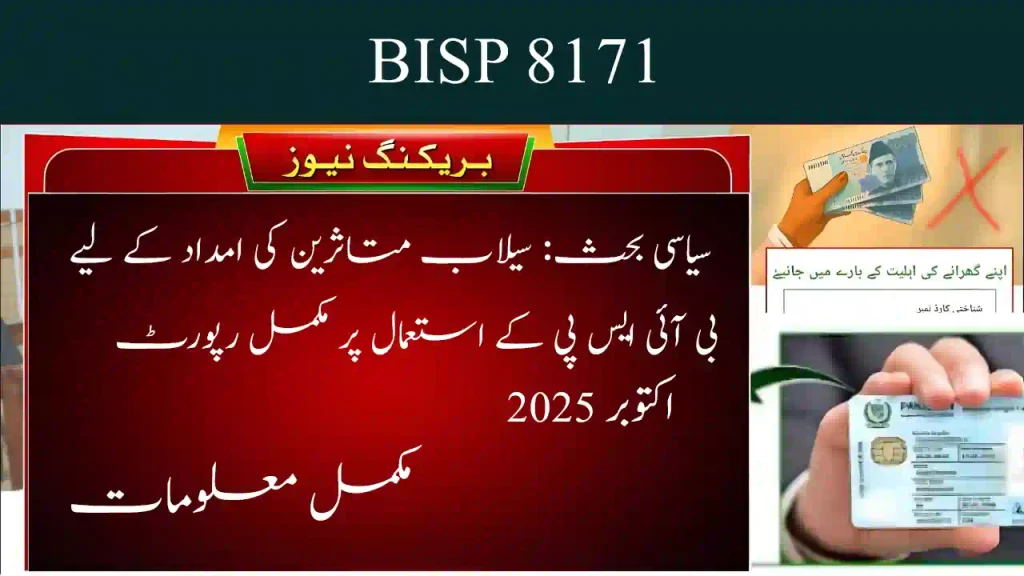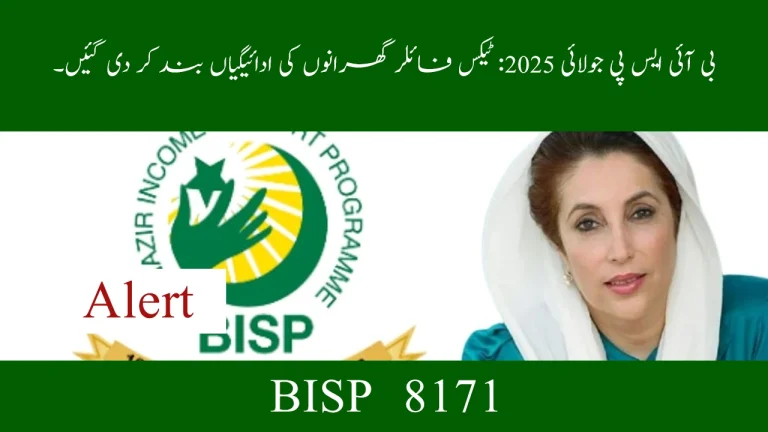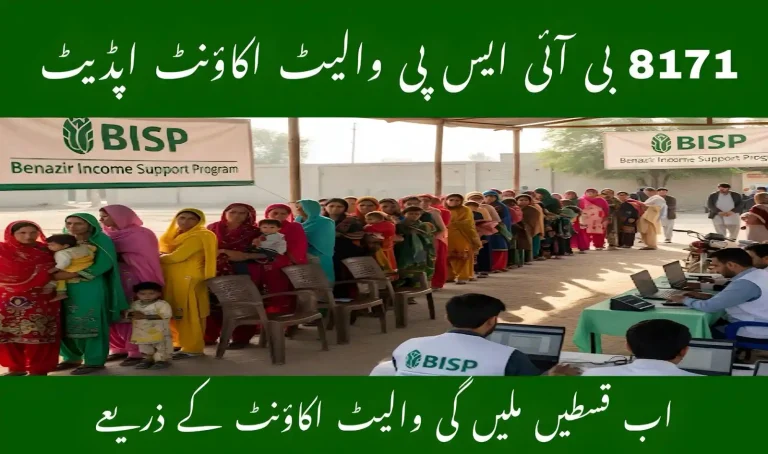Political Debate Over Use of BISP for Flood Relief – October 2025 Full Report

The language is clear (6th–8th grade level), written to survive Google’s algorithm updates, and designed to rank high with natural keyword integration like BISP Flood Relief 2025, Benazir Income Support Programme debate, and Pakistan flood aid controversy.
Introduction
As Pakistan entered October 2025, heavy monsoon rains caused destructive flooding in several provinces—particularly in Punjab, Sindh, and parts of Balochistan. Thousands of homes were washed away, crops destroyed, and roads cut off. Once again, Pakistan faced not only a humanitarian crisis but also a political storm over how to deliver emergency relief.
At the center of this storm is the Benazir Income Support Programme (BISP)—the country’s flagship social welfare program. The question dividing political parties, policymakers, and citizens alike is simple yet crucial:
Should BISP be used to distribute flood relief funds to victims of the 2025 floods?
Supporters argue that BISP already has the structure and technology to reach needy families quickly. Opponents claim that using it for disaster relief may politicize the process, exclude deserving victims, or give one party too much control.
The debate has turned into one of Pakistan’s most talked-about political issues this October, exposing the country’s ongoing struggle to balance politics, policy, and compassion in times of crisis.
Understanding BISP and Its Role
The Benazir Income Support Programme, established in 2008, was created to provide cash assistance to Pakistan’s poorest families. Named after former Prime Minister Benazir Bhutto, it remains one of the most recognized poverty-alleviation programs in South Asia.
Over the years, BISP has evolved from manual cash transfers to a modern, digitized system using biometric verification and electronic payments. It targets women from low-income households, providing them with quarterly stipends to help cover food, healthcare, and education costs.
The heart of BISP is its National Socio-Economic Registry (NSER), a massive database that collects information about families’ income, housing, and living conditions. This registry enables the government to identify eligible beneficiaries across all provinces.
Because of this established network, many see BISP as the most practical system to channel immediate financial relief during emergencies such as floods, earthquakes, or economic shocks.
Why the Debate Intensified in October 2025
The floods of late 2025 caused unprecedented damage across Punjab, Sindh, and southern Khyber Pakhtunkhwa. As images of submerged villages and displaced families spread, the federal government began evaluating options for quick aid delivery.
It seemed natural to use BISP, which already reaches millions of vulnerable households nationwide. But this proposal immediately sparked resistance from some political quarters.
Here’s what triggered the dispute:
- The Federal View: The federal government, backed by some coalition partners, suggested that using BISP would ensure speed, accountability, and equal access across all provinces.
- The Provincial Concern: Punjab’s leadership argued that flood victims include many middle-class farmers and small business owners who are not on the BISP list. They insisted on using provincial disaster funds and local systems instead.
- The Political Dimension: Since BISP is historically associated with the Pakistan Peoples Party (PPP), opponents—especially from the Pakistan Muslim League-Nawaz (PML-N)—feared that using BISP would allow the PPP to claim political credit for relief efforts in Punjab.
Within days, the issue escalated into a full-blown political argument. Television debates, parliamentary sessions, and press conferences were dominated by one question: Who should control the flood relief funds?
Supporters of Using BISP for Flood Relief
Those advocating for BISP’s use in flood response highlight both technical and humanitarian reasons. Their main arguments include:
1. Speed and Existing Infrastructure
BISP already has payment channels through banks and mobile wallets. Relief can be distributed within days, avoiding bureaucratic delays that often plague new programs. In emergencies, every day matters.
2. Accurate Targeting through Verified Data
The NSER database allows authorities to identify low-income households with minimal duplication or manipulation. This means aid is more likely to reach genuinely poor families rather than politically favored ones.
3. Proven Track Record
BISP has been used before for disaster relief—during the 2010 super floods, the 2022 floods, and the COVID-19 lockdowns. Each time, it provided a foundation for transparent and fast cash distribution.
4. Nationwide Coverage
BISP operates across all provinces, including remote areas where provincial agencies struggle to reach. Its federal structure helps maintain a uniform standard of relief.
5. Transparency and Donor Confidence
Because BISP’s payments are traceable and audited, international donors and NGOs view it as a credible channel. This can encourage more foreign funding for Pakistan’s relief efforts.
6. Depoliticization of Aid
Supporters argue that BISP, as a legal and institutionalized program, is less prone to local favoritism. Using it could prevent political leaders from selectively distributing funds for electoral advantage.
Opponents and Their Concerns
Opposition to using BISP for flood relief stems from both practical and political reasons. Critics question whether BISP’s systems, while strong for poverty support, are flexible enough for disaster management.
1. Limited Scope of Beneficiaries
BISP targets households classified as poor based on poverty scores. Floods, however, also affect small farmers, traders, and low-income families not listed in BISP records. Relying solely on BISP might leave these victims out.
2. Outdated and Incomplete Data
Some provincial officials argue that the NSER database is outdated. Since economic conditions have changed drastically after inflation and recent crises, many families who are now poor are not yet registered.
3. Provincial Autonomy
Provincial governments, especially in Punjab, believe relief efforts should be locally managed. They fear that using a federal program limits their authority and makes them dependent on Islamabad.
4. Political Bias and Credit Distribution
Critics see the proposal as a political move to associate relief efforts with the PPP’s flagship program. This concern has made provinces hesitant, even though lives are at stake.
5. Administrative Challenges
Adapting BISP systems for flood-specific criteria could take time. Updating data, verifying new victims, and ensuring fairness require coordination that might delay urgent help.
6. Overlap with Other Programs
Pakistan already has multiple social protection initiatives under Ehsaas, provincial welfare programs, and donor-funded relief schemes. Mixing them with BISP could cause confusion and duplication.
Public Reactions and Common Questions
The public response has been mixed. Many citizens, especially flood victims, are frustrated that political arguments are slowing down relief distribution. Below are some frequently asked questions circulating among the public and on social media:
- Will everyone affected by the floods get BISP relief?
Not automatically. Only families listed in the BISP registry qualify immediately. Others may be added after verification. - Can new victims be added quickly?
Yes, but the process requires coordination between federal and provincial teams to verify flood-affected households through local surveys. - What if someone is not on the BISP list but lost everything?
The government may open special registration desks for temporary inclusion, but such measures take time. - Is there a risk of corruption?
Like any large program, risks exist, but digital transfers, biometric verification, and public dashboards can greatly reduce misuse. - Why can’t both systems work together?
Many experts believe combining BISP’s technology with provincial field operations could balance speed and local oversight.
These questions highlight public anxiety and the urgent need for clear communication and joint decision-making among leaders.
Media Coverage and Political Statements
News coverage in October 2025 has turned the BISP flood debate into a centerpiece of political discourse.
The PPP leadership has repeatedly emphasized that humanitarian crises should not be politicized. They argue that BISP is a neutral, federally backed tool designed precisely for situations like these.
Meanwhile, the PML-N government in Punjab maintains that it must have the lead role since provincial authorities are more familiar with local geography and community needs. They claim that relying solely on BISP could slow the process and exclude deserving families not yet registered.
Analysts describe this dispute as a reflection of Pakistan’s long-standing tug-of-war between centralized policymaking and provincial autonomy. Unfortunately, while the arguments continue, the real losers are the flood victims waiting for aid.
A Balanced Solution: Combining Systems for Faster Relief
Many experts and civil society organizations believe the solution lies not in choosing one side but in merging both approaches.
1. Immediate Response via BISP Channels
BISP can serve as the backbone for the first phase of cash disbursements, ensuring that aid reaches the poorest households without delay.
2. Collaboration with Provincial Disaster Authorities
Provinces can complement BISP’s work by verifying additional flood-affected families and submitting updated data for inclusion.
3. Real-Time Data Integration
Creating a shared digital platform that merges BISP’s poverty data with flood damage assessments can ensure that no deserving family is left behind.
4. Independent Oversight Committee
A national oversight body with representatives from the federal government, provinces, NGOs, and civil society can monitor distribution, prevent fraud, and publish weekly reports.
5. Communication and Transparency
Governments should maintain a public dashboard showing total funds distributed, districts covered, and families assisted. This transparency will restore trust among citizens and donors alike.
6. Post-Relief Review and Reform
Once the immediate crisis is over, authorities should evaluate the results, identify weaknesses, and reform both BISP and disaster response systems for the future.
Long-Term Lessons from the 2025 Debate
The political argument over BISP’s role in flood relief is not just about one disaster—it exposes deeper structural and governance problems in Pakistan’s social protection system.
1. Need for Integrated Databases
Pakistan needs a unified system that connects social welfare data with disaster response information. This integration would make relief operations smoother and less politicized.
2. Updating the Poverty Registry
The NSER must be regularly updated to reflect new economic realities, including inflation, job losses, and migration.
3. Reducing Political Influence
Disaster relief should remain apolitical. Introducing bipartisan or independent relief oversight mechanisms can prevent future controversies.
4. Building Provincial Capacity
While BISP operates federally, provinces should strengthen their own welfare databases and disaster management networks to complement national systems.
5. Encouraging Transparency through Technology
Using GPS tracking, mobile payment systems, and AI-based verification tools can ensure real-time accountability and prevent misuse.
6. Public Awareness and Education
Citizens need clear instructions on how to apply for relief, check eligibility, and report irregularities. Educating the public reduces confusion and increases participation.
Read this: BISP Rs. 13500 Payment Released Again for Women
Broader Social and Political Implications
The ongoing debate reveals how closely linked social welfare and politics are in Pakistan. While programs like BISP are meant for citizens’ welfare, they often become symbols of political identity and competition.
This episode also raises questions about trust—trust between the federal and provincial governments, between political parties, and between the state and its citizens.
Ultimately, Pakistan’s ability to recover from disasters depends on cooperation, not confrontation. Whether it is a flood, earthquake, or economic downturn, unity and coordination will always be more effective than rivalry.
Public Sentiment and Social Media Trends
Across social media platforms, hashtags like #BISPRelief, #FloodAid2025, and #PoliticsVsRelief have been trending. Most citizens demand that political leaders stop arguing and start delivering.
Survivors from flood-hit areas have shared videos and testimonies showing their struggles to get basic shelter and food. Many express anger that political debates have delayed assistance.
Civil society groups, student volunteers, and charities are also urging authorities to collaborate. Some are even calling for an independent relief authority to avoid repeating the same mistakes in future disasters.
Expert Recommendations for Future Disasters
Policy experts suggest the following actionable steps for the government to prevent future conflicts like this one:
- Institutionalize disaster cash support under BISP with clear emergency protocols.
- Create joint federal-provincial relief committees to manage funds and beneficiaries together.
- Develop rapid registration systems using mobile technology to onboard new victims in real time.
- Introduce accountability laws requiring weekly publication of relief data.
- Engage civil society and local NGOs to verify ground conditions and feedback.
- Launch communication hotlines to help citizens report fraud or exclusion from aid lists.
By following these steps, Pakistan can build a disaster response model that is fast, fair, and free from political manipulation.
Frequently Asked Questions (FAQ)
Why is there so much political disagreement over BISP’s use?
A: Because each political party wants control and credit for relief delivery, leading to disputes over ownership and visibility of aid programs.
Is BISP capable of handling flood relief nationwide?
A: Yes, it has the systems to manage large-scale cash transfers, but coordination with provinces is essential for full coverage.
Will flood victims outside the BISP list get help?
A: The government can temporarily expand eligibility and create emergency registration points to include newly affected families.
How can corruption or favoritism be reduced?
A: Through biometric verification, audit trails, transparent dashboards, and involvement of neutral observers.
What should be improved in future disasters?
A: Data accuracy, inter-provincial coordination, and depoliticized relief management should be top priorities.
Conclusion
The political debate over using the Benazir Income Support Programme for flood relief in October 2025 reflects both progress and persistent flaws in Pakistan’s governance system.
On one hand, BISP is a success story of digital welfare delivery—efficient, trusted, and wide-reaching. On the other hand, political mistrust and power struggles continue to hinder swift humanitarian action when citizens need it most.
In times of disaster, politics should pause. Pakistan’s leaders must recognize that floods, hunger, and loss do not distinguish between party lines. A unified approach—using BISP’s infrastructure and provincial coordination—can ensure that every affected family receives timely help.
The real measure of leadership now is not who claims credit but who delivers relief effectively. If Pakistan learns from this crisis, strengthens its systems, and prioritizes people over politics, BISP can become more than a welfare program—it can be a lifeline of unity, resilience, and hope.
Read this: Punjab Aghosh Program 2025 – A Lifeline for Mothers and Children Across Punjab






